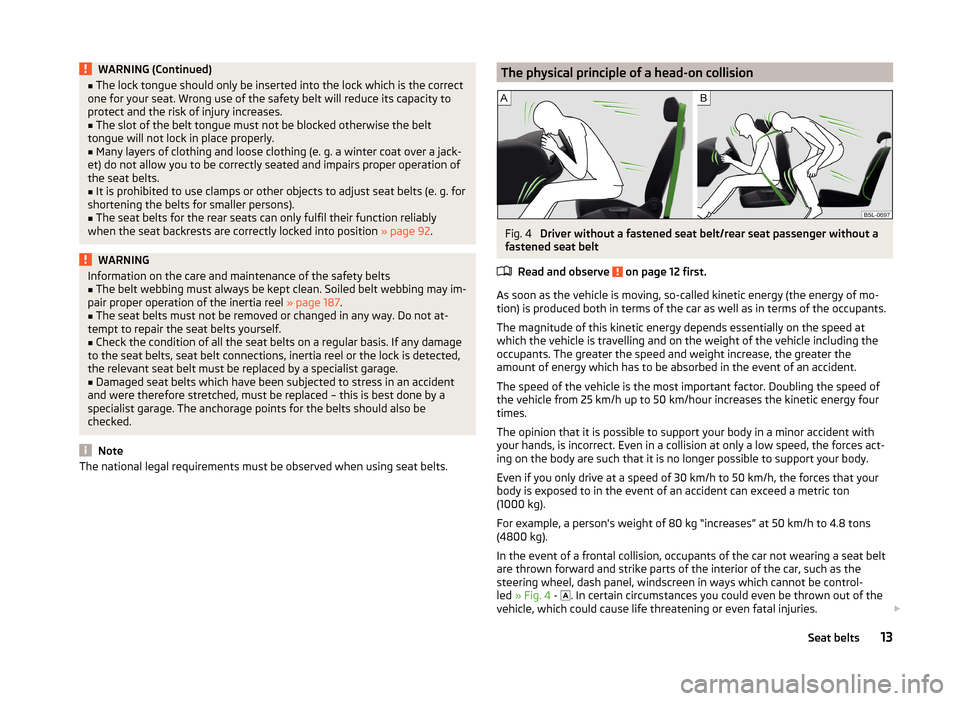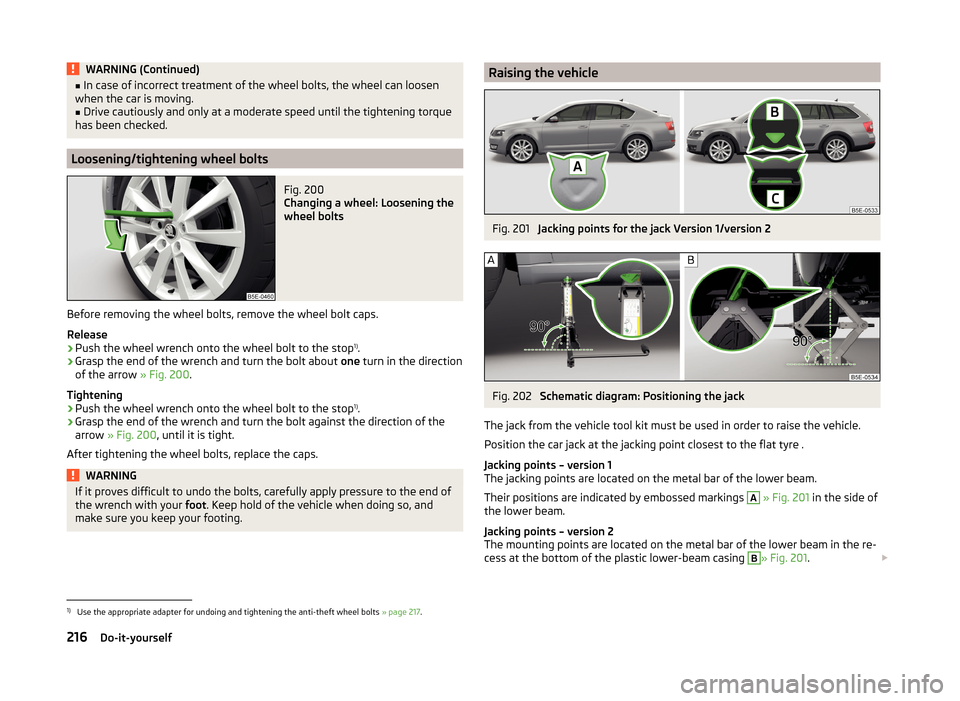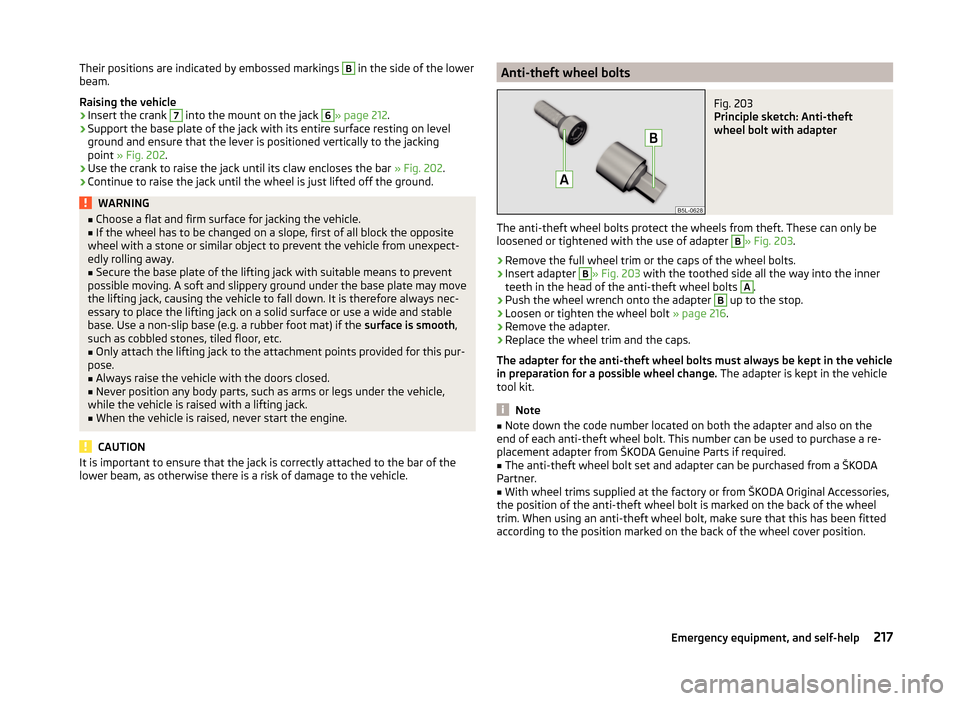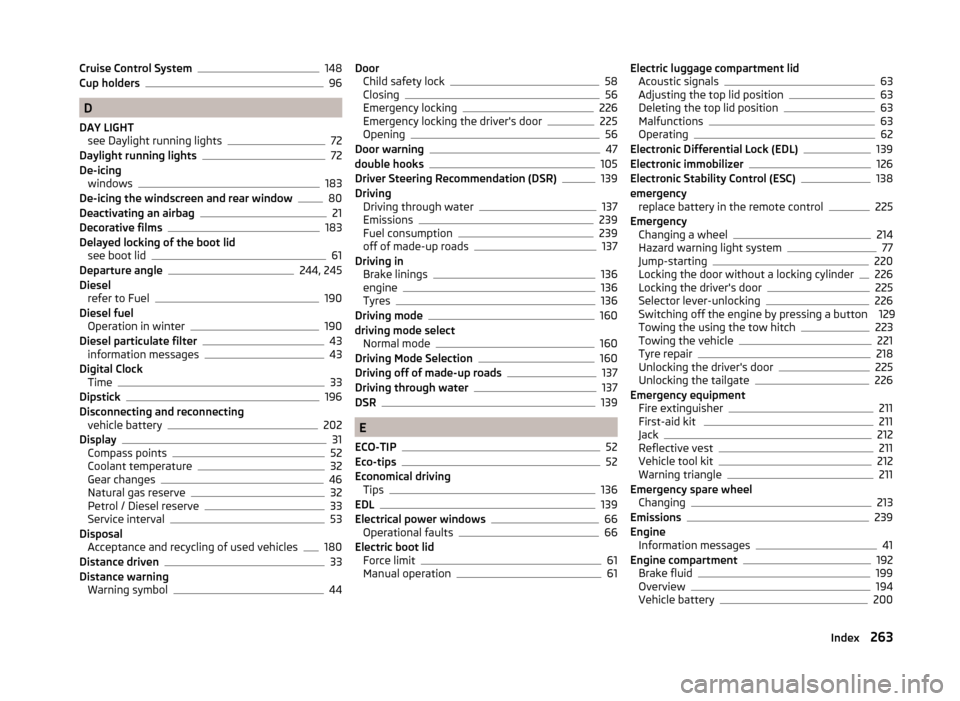jack points SKODA OCTAVIA 2014 3.G / (5E) Owner's Manual
[x] Cancel search | Manufacturer: SKODA, Model Year: 2014, Model line: OCTAVIA, Model: SKODA OCTAVIA 2014 3.G / (5E)Pages: 280, PDF Size: 35.53 MB
Page 16 of 280

WARNING (Continued)■The lock tongue should only be inserted into the lock which is the correct
one for your seat. Wrong use of the safety belt will reduce its capacity to
protect and the risk of injury increases.■
The slot of the belt tongue must not be blocked otherwise the belt
tongue will not lock in place properly.
■
Many layers of clothing and loose clothing (e. g. a winter coat over a jack-
et) do not allow you to be correctly seated and impairs proper operation of
the seat belts.
■
It is prohibited to use clamps or other objects to adjust seat belts (e. g. for
shortening the belts for smaller persons).
■
The seat belts for the rear seats can only fulfil their function reliably
when the seat backrests are correctly locked into position » page 92.
WARNINGInformation on the care and maintenance of the safety belts■The belt webbing must always be kept clean. Soiled belt webbing may im-
pair proper operation of the inertia reel » page 187.■
The seat belts must not be removed or changed in any way. Do not at-
tempt to repair the seat belts yourself.
■
Check the condition of all the seat belts on a regular basis. If any damage
to the seat belts, seat belt connections, inertia reel or the lock is detected,
the relevant seat belt must be replaced by a specialist garage.
■
Damaged seat belts which have been subjected to stress in an accident
and were therefore stretched, must be replaced – this is best done by a
specialist garage. The anchorage points for the belts should also be
checked.
Note
The national legal requirements must be observed when using seat belts.The physical principle of a head-on collisionFig. 4
Driver without a fastened seat belt/rear seat passenger without a
fastened seat belt
Read and observe
on page 12 first.
As soon as the vehicle is moving, so-called kinetic energy (the energy of mo-
tion) is produced both in terms of the car as well as in terms of the occupants.
The magnitude of this kinetic energy depends essentially on the speed at
which the vehicle is travelling and on the weight of the vehicle including the
occupants. The greater the speed and weight increase, the greater the
amount of energy which has to be absorbed in the event of an accident.
The speed of the vehicle is the most important factor. Doubling the speed of
the vehicle from 25 km/h up to 50 km/hour increases the kinetic energy four
times.
The opinion that it is possible to support your body in a minor accident with
your hands, is incorrect. Even in a collision at only a low speed, the forces act-
ing on the body are such that it is no longer possible to support your body.
Even if you only drive at a speed of 30 km/h to 50 km/h, the forces that your
body is exposed to in the event of an accident can exceed a metric ton
(1000 kg).
For example, a person's weight of 80 kg “increases” at 50 km/h to 4.8 tons
(4800 kg).
In the event of a frontal collision, occupants of the car not wearing a seat belt
are thrown forward and strike parts of the interior of the car, such as the
steering wheel, dash panel, windscreen in ways which cannot be control-
led » Fig. 4 -
. In certain circumstances you could even be thrown out of the
vehicle, which could cause life threatening or even fatal injuries.
13Seat belts
Page 219 of 280

WARNING (Continued)■In case of incorrect treatment of the wheel bolts, the wheel can loosen
when the car is moving.■
Drive cautiously and only at a moderate speed until the tightening torque
has been checked.
Loosening/tightening wheel bolts
Fig. 200
Changing a wheel: Loosening the
wheel bolts
Before removing the wheel bolts, remove the wheel bolt caps.
Release
›
Push the wheel wrench onto the wheel bolt to the stop 1)
.
›
Grasp the end of the wrench and turn the bolt about one turn in the direction
of the arrow » Fig. 200.
Tightening
›
Push the wheel wrench onto the wheel bolt to the stop 1)
.
›
Grasp the end of the wrench and turn the bolt against the direction of the
arrow » Fig. 200 , until it is tight.
After tightening the wheel bolts, replace the caps.
WARNINGIf it proves difficult to undo the bolts, carefully apply pressure to the end of
the wrench with your foot. Keep hold of the vehicle when doing so, and
make sure you keep your footing.Raising the vehicleFig. 201
Jacking points for the jack Version 1/version 2
Fig. 202
Schematic diagram: Positioning the jack
The jack from the vehicle tool kit must be used in order to raise the vehicle.
Position the car jack at the jacking point closest to the flat tyre .
Jacking points – version 1
The jacking points are located on the metal bar of the lower beam.
Their positions are indicated by embossed markings
A
» Fig. 201 in the side of
the lower beam.
Jacking points – version 2
The mounting points are located on the metal bar of the lower beam in the re-
cess at the bottom of the plastic lower-beam casing
B
» Fig. 201 .
1)
Use the appropriate adapter for undoing and tightening the anti-theft wheel bolts
» page 217.
216Do-it-yourself
Page 220 of 280

Their positions are indicated by embossed markings B in the side of the lower
beam.
Raising the vehicle›
Insert the crank
7
into the mount on the jack
6
» page 212 .
›
Support the base plate of the jack with its entire surface resting on level
ground and ensure that the lever is positioned vertically to the jacking
point » Fig. 202 .
›
Use the crank to raise the jack until its claw encloses the bar » Fig. 202.
›
Continue to raise the jack until the wheel is just lifted off the ground.
WARNING■
Choose a flat and firm surface for jacking the vehicle.■If the wheel has to be changed on a slope, first of all block the opposite
wheel with a stone or similar object to prevent the vehicle from unexpect-
edly rolling away.■
Secure the base plate of the lifting jack with suitable means to prevent
possible moving. A soft and slippery ground under the base plate may move
the lifting jack, causing the vehicle to fall down. It is therefore always nec-
essary to place the lifting jack on a solid surface or use a wide and stable
base. Use a non-slip base (e.g. a rubber foot mat) if the surface is smooth,
such as cobbled stones, tiled floor, etc.
■
Only attach the lifting jack to the attachment points provided for this pur-
pose.
■
Always raise the vehicle with the doors closed.
■
Never position any body parts, such as arms or legs under the vehicle,
while the vehicle is raised with a lifting jack.
■
When the vehicle is raised, never start the engine.
CAUTION
It is important to ensure that the jack is correctly attached to the bar of the
lower beam, as otherwise there is a risk of damage to the vehicle.Anti-theft wheel boltsFig. 203
Principle sketch: Anti-theft
wheel bolt with adapter
The anti-theft wheel bolts protect the wheels from theft. These can only be
loosened or tightened with the use of adapter
B
» Fig. 203 .
›
Remove the full wheel trim or the caps of the wheel bolts.
›
Insert adapter
B
» Fig. 203 with the toothed side all the way into the inner
teeth in the head of the anti-theft wheel bolts
A
.
›
Push the wheel wrench onto the adapter
B
up to the stop.
›
Loosen or tighten the wheel bolt » page 216.
›
Remove the adapter.
›
Replace the wheel trim and the caps.
The adapter for the anti-theft wheel bolts must always be kept in the vehicle
in preparation for a possible wheel change. The adapter is kept in the vehicle
tool kit.
Note
■ Note down the code number located on both the adapter and also on the
end of each anti-theft wheel bolt. This number can be used to purchase a re-
placement adapter from ŠKODA Genuine Parts if required.■
The anti-theft wheel bolt set and adapter can be purchased from a ŠKODA
Partner.
■
With wheel trims supplied at the factory or from ŠKODA Original Accessories,
the position of the anti-theft wheel bolt is marked on the back of the wheel
trim. When using an anti-theft wheel bolt, make sure that this has been fitted
according to the position marked on the back of the wheel cover position.
217Emergency equipment, and self-help
Page 266 of 280

Cruise Control System148
Cup holders96
D
DAY LIGHT see Daylight running lights
72
Daylight running lights72
De-icing windows
183
De-icing the windscreen and rear window80
Deactivating an airbag21
Decorative films183
Delayed locking of the boot lid see boot lid
61
Departure angle244, 245
Diesel refer to Fuel
190
Diesel fuel Operation in winter
190
Diesel particulate filter43
information messages43
Digital Clock Time
33
Dipstick196
Disconnecting and reconnecting vehicle battery
202
Display31
Compass points52
Coolant temperature32
Gear changes46
Natural gas reserve32
Petrol / Diesel reserve33
Service interval53
Disposal Acceptance and recycling of used vehicles
180
Distance driven33
Distance warning Warning symbol
44
DoorChild safety lock58
Closing56
Emergency locking226
Emergency locking the driver's door225
Opening56
Door warning47
double hooks105
Driver Steering Recommendation (DSR)139
Driving Driving through water
137
Emissions239
Fuel consumption239
off of made-up roads137
Driving in Brake linings
136
engine136
Tyres136
Driving mode160
driving mode select Normal mode
160
Driving Mode Selection160
Driving off of made-up roads137
Driving through water137
DSR139
E
ECO-TIP
52
Eco-tips52
Economical driving Tips
136
EDL139
Electrical power windows66
Operational faults66
Electric boot lid Force limit
61
Manual operation61
Electric luggage compartment lid Acoustic signals63
Adjusting the top lid position63
Deleting the top lid position63
Malfunctions63
Operating62
Electronic Differential Lock (EDL)139
Electronic immobilizer126
Electronic Stability Control (ESC)138
emergency replace battery in the remote control
225
Emergency Changing a wheel
214
Hazard warning light system77
Jump-starting220
Locking the door without a locking cylinder226
Locking the driver's door225
Selector lever-unlocking226
Switching off the engine by pressing a button 129
Towing the using the tow hitch
223
Towing the vehicle221
Tyre repair218
Unlocking the driver's door225
Unlocking the tailgate226
Emergency equipment Fire extinguisher
211
First-aid kit 211
Jack212
Reflective vest211
Vehicle tool kit212
Warning triangle211
Emergency spare wheel Changing
213
Emissions239
Engine Information messages
41
Engine compartment192
Brake fluid199
Overview194
Vehicle battery200
263Index